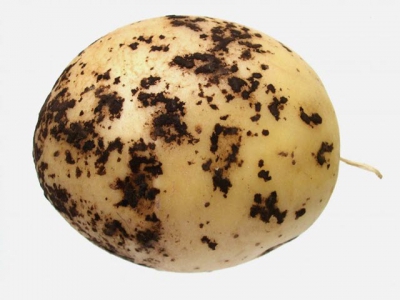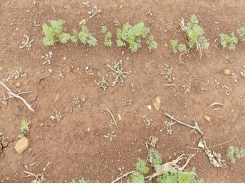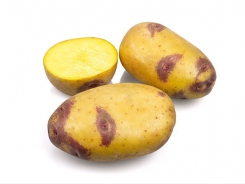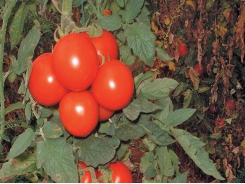More common potato diseases

Early blight is caused by the fungus Alternaria solani, and attacks tomatoes as well as potatoes.
It’s associated with warm temperatures (28°C-30°C) and prolonged wet periods, or rapidly alternating wet and dry periods. When these conditions are present, the disease will usually appear a week later. Older leaves are particularly susceptible, but all parts are vulnerable, including stems and tubers. Plants which are infected when young can have the stems ‘girdled’. The disease starts off as small brown spots which make concentric rings as they increase in size.
The fungus overwinters on crop residue, but resistant spores can also be formed. Infected crops nearby or a high level of spores on crop residues will result in a greater initial infection. Once it attacks, the disease goes through several cycles and has the capacity to completely destroy a crop.
Where you have a history of the disease, or when favourable conditions develop, use preventative sprays to protect the foliage.
These would include copper and dithiocarbamate products. They’re usually quite effective and also protect the crop against late blight. If the disease starts to develop, you need a systemic product. These should not be overused, but alternated with unrelated products in order to preserve the effective lifespan of these products. Ask your pest control representative for advice on this.
Viruses
There are various viruses which attack potatoes. Most are spread primarily by aphids and severely reduce yields. In these instances there’s nothing you can do to control the disease once a plant is infected. This is why you should use certified seed potatoes. Registered growers have their crops inspected at appropriate times to ensure there’s no, or very little, virus in the tubers you buy. It’s like paying for insurance.
Symptoms are easily spotted in a land as the plants become a lighter colour and leaves are stunted and misshaped. In a normal commercial land, it’s not too serious if there are only a few infected plants. But there can be a problem if the crop isn’t certified and there’s a fair level of infection. If the young plants become infected with aphids, the disease can spread rapidly.
The degree of loss will be proportionate to the age of the plant when infected.
Scab
Another common disease is scab, which makes rough, sunken lesions on the tubers. It downgrades the potatoes and can result in total rejection of the crop. Scab is active at a pH of 5,5 to 7,5 with an optimum of 6,1 to 6,5. In other words, it’s active at a pH suitable for growing many crops. Thus the disease can also attack the fleshy roots of many weeds and vegetables, and you need long rotations with grass maize or wheat to reduce the spore count. Sandy, hot soils are also more vulnerable.
Registered fungicides can be applied at planting, but this adds to your production costs. If you choose this option, take care to follow the directions very closely! A better solution is to plant varieties which have resistance to this disease. Another approach is to irrigate frequently with a modest amount of water to keep the soil’s moisture at a level good for plant growth. But don’t allow the soil to become too wet and then dry in quick succession. Keeping the soil moisture level as constant as possible won’t only reduce scab substantially, but will also give you a bumper crop as a bonus.
Related news
Tools

Phối trộn thức ăn chăn nuôi

Pha dung dịch thủy canh

Định mức cho tôm ăn

Phối trộn phân bón NPK

Xác định tỷ lệ tôm sống

Chuyển đổi đơn vị phân bón

Xác định công suất sục khí

Chuyển đổi đơn vị tôm

Tính diện tích nhà kính

Tính thể tích ao




 How tomato growers can practice IPM
How tomato growers can practice IPM  Leafy crop vs fruiting crop the balancing act
Leafy crop vs fruiting crop the balancing act